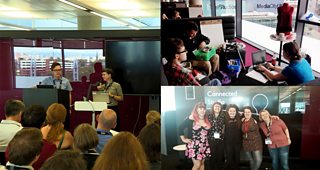Connected Studio: Coding for Teenagers Build Studio
Kerensa Jennings
Head Strategic Delivery
Tagged with:
I don’t know who was more excited - the seven shortlisted teams who had beaten thirty other fantastic projects to be selected for the Build Studio event. Or us – the Â鶹ԼÅÄ project team. Either way, the energy and anticipation in the room were palpable.
For anyone unaware of what we’re up to – we are in the middle of a . We set which asked: what’s the best digital solution we could create to inspire younger teenagers – and especially girls - to discover coding in an appealing and entertaining way?

The bit was a two-day prototype-building extravaganza. As Day One unfolded, each of the teams set up camp on the top floor of a sun-filled upper floor in a building at Â鶹ԼÅÄ MediaCity UK. Outside, views of Salford stretched for miles and miles. Inside, flipcharts were being set up, notebooks laid out – and in one case – a tailor’s dummy put in place.
The air began to hum with activity as each team started to think through how best to bring their ideas to life in a prototype of some sort. The countdown began. By the end of the next day, the teams would be pitching their prototypes and strategies in just ten minutes to win the chance to go through to the development stage.
So. Day One. The judging teams got together and re-evaluated the shortlisted projects, agreeing key pieces of guidance and direction we should give each of the groups. We then began a slow rotation around the room, stopping off at each project zone. Inevitably, we’d gathered into what our planner had called a ‘huddle’. One by one, we chatted to each group, answered any questions they had and tried to give them steers on what we thought would be useful to focus on.
The first time I went to Â鶹ԼÅÄ North, I was dazzled by the buildings and the vibrancy of the place. It’s one of the most creative places in the Â鶹ԼÅÄ â€“ and with its jazzy monochrome carpets and liquorice allsorts colour scheme, how could anyone fail to be inspired? It certainly seemed to be working on the teams. Fuelled by coffee and cookies, there was a festive spirit in the air as the pace picked up through the afternoon.
One group - of awe-inspiring teenage developers, as it happens – was busy tearing up bits of paper and moving them around a makeshift grid as they plotted moves and mechanics.
Another had a young woman programmer, fingertips seemingly glued to her device, churning out code as if she was typing a well-rehearsed story.
Perched on the edge of a sofa in another of the teams was a chap with a warm cup of water and a handful of white, melting stuff that he was mysteriously dipping into the liquid. To soften, apparently. He didn’t give away much at that point so for the rest of us it seemed either cool and enigmatic or slightly bonkers.
Part way through the afternoon, the teams got to meet target audience groups to test theories and get some early feedback. The idea was to give them the chance to hone their projects with real, live audience insight.
The hours whizzed by and before we knew it, the July sun began to set. Somewhat fittingly, a rather lovely rainbow arced across the sky. We gathered around in a circle and gave each other an update on progress so far. Tired but enthused, we packed everyone off for a well-deserved rest and arranged to meet up bright and early the next day.
Day Two had a frenetic yet excited edge to it. The judging huddle circled around again and reminded everyone to focus on two key things – how was their proposition going to appeal to our target audience? And what was it about their idea that would be somehow enhanced by working with the Â鶹ԼÅÄ?
As four o’clock loomed large, the teams practiced their pitches and reached for one last gulp of coffee. It was time to present the prototypes.
Dragon’s Den style, we judges lined up on the front row. Needless to say, we weren’t disappointed. It was quite extraordinary what the teams had managed to accomplish in just two days. And I loved the different ways they showcased their ideas.
One group used eye-catchingly creative pictures they had taken of themselves to illustrate one application of their work; another gave us a nail-biting live demo using the co-ordinates of the Quay House building. There was the group that had managed to get access to Radio 1 DJ Greg James to make a polished video as part of their presentation. Another team cleverly manipulated Â鶹ԼÅÄ assets to brilliant effect. One project gave us a really smart insight into their thinking into what might appeal to teenage girls by showing the link between their idea and the popularity of loom bands. Then there was the project that lit up the stage with some twinkly lights; and the team who showcased how their idea could be skinned for different applications with different audience groups across Â鶹ԼÅÄ channels and services. All in all a roll call of coding creativity.
Us judges are getting together soon to review the pitches and make our bets. I can assure you of one thing – it isn’t going to be easy.
As I said to the teams at the end of the sessions – they’ve given us such a challenging task, choosing who goes through to the next stage is a rather nice problem to have. I’ll be back soon to let you know how we get on. Watch this space…
Kerensa Jennings is Head of Strategic Delivery, Â鶹ԼÅÄ
